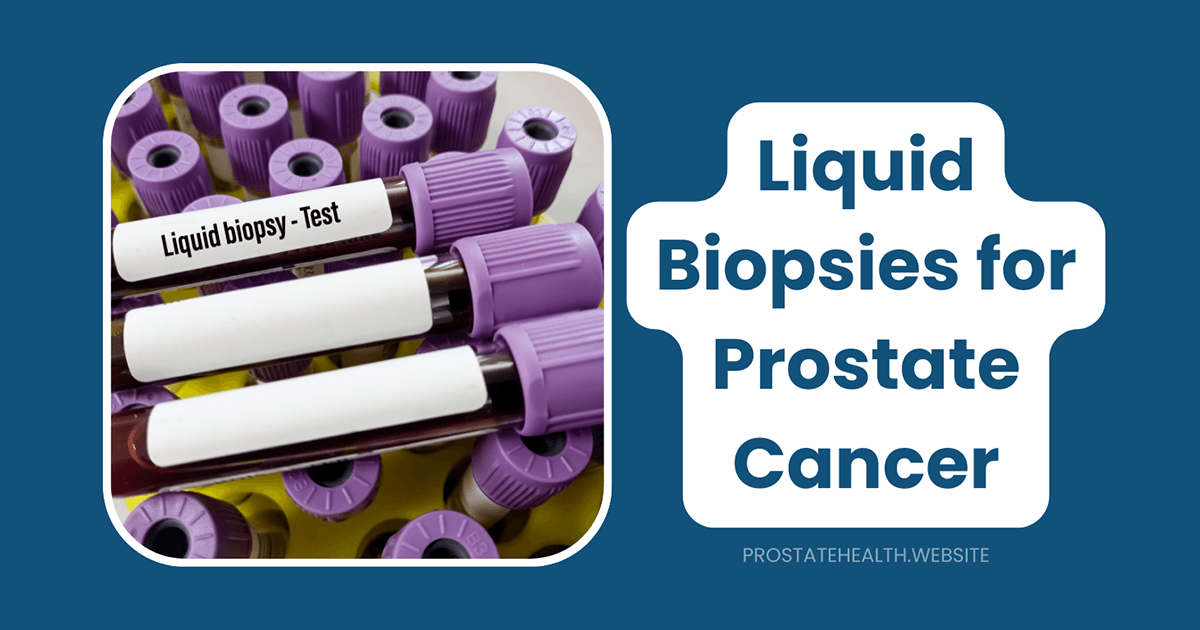Liquid Biopsies for Prostate Cancer: The Future of Diagnosis?

For decades, the journey to prostate cancer diagnosis has followed a familiar and often uncomfortable path: elevated PSA test, digital rectal exam, and ultimately, an invasive needle biopsy. This approach, while valuable, comes with limitations—from false positives leading to unnecessary procedures to the physical and emotional toll of invasive biopsies.
But what if a simple blood test could tell you not only whether you have prostate cancer, but also how aggressive it is and which treatments might work best? This isn’t science fiction—it’s the promise of liquid biopsy technology, an emerging approach that’s poised to transform how we detect, monitor, and treat prostate cancer.
As someone who’s spoken with hundreds of men navigating prostate cancer diagnosis and treatment, I’ve witnessed firsthand the anxiety that comes with traditional diagnostic methods. Liquid biopsies offer hope for a less invasive, more informative future—one that could spare men unnecessary procedures while providing more personalized care for those who need it.
What Is a Liquid Biopsy?
Unlike traditional tissue biopsies that require removing cells directly from the prostate, liquid biopsies analyze biomarkers found in bodily fluids—primarily blood, but also urine and even semen. These biomarkers include:
Circulating Tumor DNA (ctDNA)
When cancer cells die, they release fragments of their DNA into the bloodstream. This circulating tumor DNA carries the genetic mutations and alterations specific to the cancer, creating a genetic “fingerprint” that can be detected and analyzed.
Circulating Tumor Cells (CTCs)
These are intact cancer cells that have detached from the tumor and entered the bloodstream. Though rare (typically just a few CTCs per billion blood cells), these cells provide valuable information about the cancer’s characteristics.
Exosomes
These tiny vesicles released by cells contain proteins, RNA, and DNA that can serve as biomarkers for cancer detection. Prostate cancer cells release exosomes with specific molecular signatures that can be identified.
Non-coding RNA
MicroRNAs and other non-coding RNA molecules play important roles in gene regulation and are often dysregulated in cancer. Specific patterns of these molecules can indicate the presence and characteristics of prostate cancer.
As Robert, a 62-year-old patient who participated in a liquid biopsy trial in 2025, told me: “After three traditional biopsies over the years, having a simple blood draw that could tell my doctors more about my cancer was like a miracle. No pain, no recovery time, just information.”
How Liquid Biopsies Are Changing Prostate Cancer Care
The potential applications of liquid biopsies span the entire prostate cancer care continuum:
1. Early Detection and Screening
Traditional PSA testing has well-documented limitations, including a high rate of false positives that lead to unnecessary biopsies. According to the American Cancer Society, only about 25% of men with elevated PSA levels who undergo a biopsy actually have prostate cancer.
Liquid biopsies offer a more nuanced approach:
- Enhanced accuracy: By analyzing multiple biomarkers simultaneously, liquid biopsies can achieve greater specificity than PSA alone
- Risk stratification: Identifying which elevated PSA results warrant further investigation
- Reduced unnecessary biopsies: Potentially sparing men from invasive procedures when cancer is unlikely
A 2025 study published in the Journal of Clinical Oncology found that a multi-biomarker liquid biopsy test could reduce unnecessary prostate biopsies by up to 37% while missing fewer clinically significant cancers than the PSA test alone.
2. Diagnosis and Characterization
When prostate cancer is suspected, liquid biopsies can provide valuable information:
- Cancer confirmation: Detecting cancer-specific genetic alterations
- Aggressiveness assessment: Identifying markers associated with more aggressive disease
- Molecular profiling: Characterizing the genetic makeup of the cancer to guide treatment decisions
“The liquid biopsy didn’t just tell us I had prostate cancer,” shared Michael, 58. “It showed specific genetic mutations that helped my doctor recommend the most effective treatment approach for my particular cancer.”
3. Treatment Selection and Monitoring
Perhaps the most immediate impact of liquid biopsies is in guiding treatment decisions and monitoring response:
- Precision medicine: Matching patients with targeted therapies based on specific genetic alterations
- Real-time monitoring: Tracking treatment effectiveness through changes in biomarker levels
- Early detection of resistance: Identifying when a treatment is no longer working, often before clinical symptoms appear
The 2025 APCCC Diagnostics meeting highlighted how ctDNA dynamics have prognostic value in advanced prostate cancer, with “conversion” (significant reduction in ctDNA levels) after treatment serving as a powerful indicator of treatment effectiveness.
4. Recurrence Monitoring
For men who have completed initial treatment, liquid biopsies offer a less invasive way to monitor for cancer recurrence:
- Earlier detection: Identifying recurrence months before conventional imaging or PSA tests
- Minimal residual disease (MRD) detection: Finding tiny amounts of cancer that remain after treatment
- Peace of mind: More frequent, less invasive monitoring for men in remission
A landmark study presented at the 2025 American Society of Clinical Oncology meeting showed that ctDNA detection could identify prostate cancer recurrence an average of 8.7 months earlier than conventional methods.
The Science Behind Liquid Biopsies
The technology enabling liquid biopsies has advanced dramatically in recent years, making what once seemed impossible now clinically feasible:
Next-Generation Sequencing (NGS)
This technology can rapidly sequence millions of DNA fragments, allowing for the detection of cancer-specific mutations even when they represent a tiny fraction of the total DNA in a blood sample.
Digital Droplet PCR (ddPCR)
This highly sensitive technique partitions DNA samples into thousands of droplets and performs PCR amplification in each droplet, enabling the detection of rare genetic alterations with remarkable precision.
Artificial Intelligence and Machine Learning
Advanced algorithms help interpret complex biomarker patterns, improving the accuracy of cancer detection and characterization while reducing false positives.
Promising Biomarkers for Prostate Cancer
Research has identified several promising biomarkers specifically for prostate cancer liquid biopsies:
In Blood:
- AR-V7: The presence of this androgen receptor variant in CTCs predicts resistance to hormonal therapies like enzalutamide and abiraterone
- BRCA1/2 and ATM mutations: Identifying these mutations can help select patients who might benefit from PARP inhibitors like olaparib
- ctDNA tumor fraction: Higher levels correlate with worse outcomes and can track treatment response
In Urine:
- PCA3: A non-coding RNA highly specific to prostate cancer
- TMPRSS2-ERG fusion: A genetic alteration found in about 50% of prostate cancers
- miR-375 and miR-532-5p: MicroRNAs that correlate with tumor aggressiveness and metastasis
In Semen:
- Exosomal biomarkers: Emerging research shows that semen contains cancer-specific exosomes that may provide even more specific information about prostate tumors
Current Limitations and Challenges
While the potential of liquid biopsies is enormous, several challenges remain:
Sensitivity and Specificity
Early-stage or small tumors release less genetic material into the bloodstream, making detection more difficult. Current technologies may miss some cancers, particularly at very early stages.
Standardization
Different laboratories use different techniques and thresholds, making it difficult to compare results across studies or institutions. Efforts are underway to standardize these approaches.
Cost and Accessibility
Many advanced liquid biopsy tests remain expensive and are not yet widely available outside major medical centers. However, costs are decreasing as technology advances and adoption increases.
Clinical Validation
While evidence supporting liquid biopsies is growing rapidly, more large-scale clinical trials are needed to definitively establish their role in routine prostate cancer care.
Real-World Applications in 2025
Despite these challenges, liquid biopsies are already making their way into clinical practice:
FDA-Approved Tests
Several liquid biopsy tests have received FDA approval for specific applications in prostate cancer, including:
- Guardant360® CDx: Approved for identifying patients with metastatic castration-resistant prostate cancer who may benefit from PARP inhibitors
- Foundation One Liquid CDx: Detects genomic alterations to guide targeted therapy selection
- ProstaSeq™: A urine-based test that combines multiple biomarkers to assess prostate cancer risk and aggressiveness
Clinical Guidelines
The 2025 National Comprehensive Cancer Network (NCCN) guidelines now include recommendations for liquid biopsy testing in specific clinical scenarios:
- For men with metastatic prostate cancer to identify actionable genetic alterations
- For monitoring treatment response in advanced disease
- As an option for men with rising PSA after definitive treatment
Insurance Coverage
Medicare and many private insurers now provide coverage for liquid biopsy tests in specific clinical scenarios, though coverage policies vary widely.
The Patient Experience: Less Invasive, More Informative
Beyond the clinical benefits, liquid biopsies offer significant advantages from the patient perspective:
Minimal Discomfort
A simple blood draw replaces or supplements the need for invasive tissue biopsies, reducing pain, anxiety, and recovery time.
Reduced Complications
Traditional prostate biopsies carry risks of bleeding, infection, and urinary problems. Liquid biopsies eliminate these risks.
More Frequent Monitoring
The non-invasive nature of liquid biopsies makes it practical to monitor cancer more frequently, potentially catching changes earlier.
Comprehensive Information
Liquid biopsies can provide information about the entire tumor burden, not just the small portion sampled in a traditional biopsy.
As James, a 65-year-old with advanced prostate cancer, shared: “Before liquid biopsies, I dreaded each follow-up because it meant more scans, more waiting, more uncertainty. Now, a simple blood test gives my doctor real-time information about how my treatment is working. It’s changed everything about my cancer journey.”
The Future of Liquid Biopsies for Prostate Cancer
Looking ahead, several exciting developments are on the horizon:
Multi-Cancer Early Detection
Researchers are developing liquid biopsy tests that can screen for multiple cancer types, including prostate cancer, from a single blood sample. These tests could revolutionize cancer screening by making it simpler and more comprehensive.
At-Home Testing
The simplicity of blood or urine collection opens the possibility of at-home testing kits that could be mailed to a laboratory, making screening more accessible, particularly for men in rural areas.
Integration with Wearable Technology
Future “smart” wearable devices might continuously monitor cancer biomarkers in bodily fluids, alerting patients and doctors to significant changes that warrant attention.
AI-Enhanced Analysis
Artificial intelligence will continue to improve the interpretation of liquid biopsy results, potentially identifying patterns and correlations that human analysts might miss.
What This Means for You
If you’re a man concerned about prostate cancer or currently navigating diagnosis or treatment, here’s what you should know about liquid biopsies:
If You’re at Risk for Prostate Cancer
- Ask your doctor about emerging liquid biopsy screening options that might complement traditional PSA testing
- Consider participating in clinical trials evaluating new liquid biopsy approaches
- Stay informed about advances in this rapidly evolving field
If You’re Facing a Prostate Cancer Diagnosis
- Discuss with your doctor whether liquid biopsy testing might provide additional information to guide your treatment decisions
- Ask about tests that can identify specific genetic alterations that might make you eligible for targeted therapies
- Consider how liquid biopsy monitoring might fit into your overall care plan
If You’re Undergoing Treatment
- Talk to your oncologist about using liquid biopsies to monitor your treatment response
- Ask whether periodic liquid biopsy testing might detect resistance earlier than traditional monitoring
- Discuss how liquid biopsy results might be used to adjust your treatment plan
If You’re in Remission
- Explore whether liquid biopsy monitoring might provide earlier detection of potential recurrence
- Ask about minimal residual disease (MRD) testing to confirm complete response to treatment
- Consider how liquid biopsy monitoring might provide peace of mind with less invasive testing
Questions to Ask Your Doctor
- Is liquid biopsy testing appropriate for my specific situation?
- What information would a liquid biopsy provide that traditional tests wouldn’t?
- Is liquid biopsy testing covered by my insurance?
- How would the results of a liquid biopsy influence my treatment plan?
- Are there clinical trials involving liquid biopsies that I might be eligible for?
- How often should liquid biopsy testing be repeated?
- What are the limitations of liquid biopsy testing for my type and stage of prostate cancer?
Conclusion: A Less Invasive Future
Liquid biopsies represent one of the most promising advances in prostate cancer care in decades. By providing detailed molecular information through a simple blood draw, they offer the potential for earlier detection, more precise treatment selection, and less invasive monitoring.
While challenges remain in bringing this technology to all men who might benefit, the rapid pace of research and development suggests that liquid biopsies will play an increasingly important role in prostate cancer care in the coming years.
As Thomas, a 70-year-old prostate cancer survivor who has benefited from liquid biopsy monitoring, told me: “After everything I went through with traditional biopsies and treatments, it’s amazing to think that future generations of men might be spared much of that discomfort. A simple blood test that can tell you more about your cancer than we ever thought possible—that’s not just medical progress, that’s a revolution in care.”
Have you or a loved one experienced liquid biopsy testing for prostate cancer? Share your experience in the comments below to help other men understand this emerging technology.






